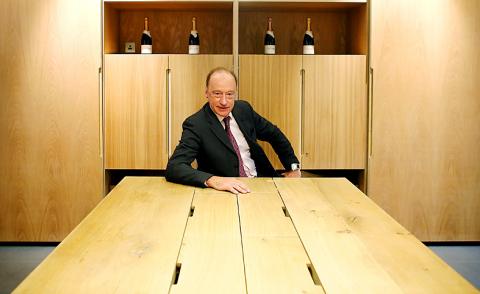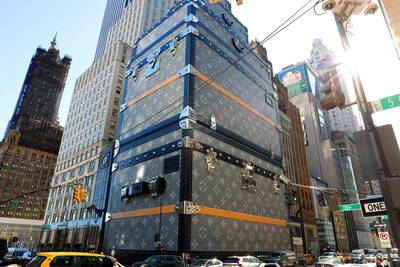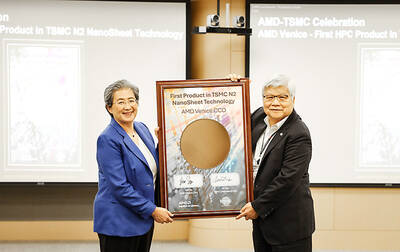With revelers raising a glass of bubbly to the new year, England’s tiny sparkling wine industry is set for a lift this year as established brands step up export plans and newcomers join the party.
Internationally, England may be known for its ale, cider and gin, but it is also home to 432 vineyards and 124 wineries. These sit mostly along the southeast coast, which has a similar geology and climate to France’s Champagne region across the English Channel.
English sparkling wine remains a drop in the bucket compared with its continental cousins, but producers are determined to hang on to their premium positioning, selling at an average of £25 (US$40.89) a bottle, even as many cost-conscious Britons turn from champagne to cheaper cava from Spain and prosecco from Italy.

Photo: Reuters
“We see ourselves as a luxury brand and we have to be judged on a world stage, not just an English stage,” said Julian Kirk, who is in charge of sales at West Sussex winemaker Nyetimber, one of the longest-established names in English sparkling wine and owner of 10 percent of the country’s vineyards.
“The British market is great, but we can’t depend on it for the long-term future,” Kirk added.
Those efforts have made the wine community sit up and take notice in recent years, earning British bubbly more than its fair share of awards.
Among them was East Sussex winemaker Ridgeview’s triumph at the 2010 Decanter World Wine Awards over several other, more illustrious champagne producers.
English sparkling wines punched above their weight again this year, with three gold medals in the prestigious International Wine Challenge. The winners were: Nyetimber, Gusbourne Estate in Kent and Dorset producer Furleigh Estate.
It should therefore come as no surprise that Nyetimber began exporting to Japan in May and Denmark in September last year.
With more than two decades of production under its belt since the 1992 debut vintage, Nyetimber is likely to start selling in the US this year and is also eyeing Singapore, Hong Kong, Australia and Denmark’s Nordic neighbors, Kirk said.
In 2012, 55,000 nine-liter cases of English sparkling wine were sold in its home market, according to wine data specialist International Wine & Spirit Research (IWSR), representing a compound annual growth of 13 percent over the past five years.
That gave the alcoholic drunk 0.6 percent of the 9.1 million cases of bubbly sold in Britain last year.
Spain, France and Italy together control 87 percent of the market, although Spain recently pulled ahead of France because of the popularity of cava as a low-cost enjoyable sparkling wine, IWSR’s Helen Windle said.
The researcher predicts that sales of sparkling wine will grow faster than any other wine category in Britain over the next few years, adding 1.7 million cases between 2012 and 2018 at a compound annual growth rate of 2.8 percent.
For champagne makers such as LVMH, Pernod Ricard and Laurent Perrier, there has been increasing speculation that they might be looking to purchase vineyards in Britain, their biggest export market.
“If we have the time, will and passion, it’s possible [to make great sparkling wine in England],” said Pierre-Emmanuel Taittinger, president of the champagne house that bears his family name, although he said it has no such plans at present.
Julia Trustram Eve, marketing director for the English Wine Producers trade group, said that the winemakers must retain their focus on quality.
Even though part of this comes from the cool weather that gives the grapes high acidity, it is also down to the traditional production method, in which second fermentation takes place inside each bottle, rather than in bulk tanks.
“It’s in our interest to make sure that anyone involved in the industry and the production of this premium wine is going to keep to those levels of quality, for the sake of our own reputation,” she said.
Digby Fine English, one of the newest English winemakers, is sticking to that strategy. Its first vintage, 2009, has just gone on sale at upmarket outlets such as Selfridges department store and Michelin-starred restaurants.
Trevor Clough, Digby’s corporate strategist-turned-CEO, said that the industry’s small size helps to support its premium price as it slowly but surely builds its reputation.
“We’re not really at the point where we want everyone to know and everyone to want to buy English wine all the time,” Clough said. “It’s all about focusing on early adopters and cultivating their enthusiasm.”

TAKING STOCK: A Taiwanese cookware firm in Vietnam urged customers to assess inventory or place orders early so shipments can reach the US while tariffs are paused Taiwanese businesses in Vietnam are exploring alternatives after the White House imposed a 46 percent import duty on Vietnamese goods, following US President Donald Trump’s announcement of “reciprocal” tariffs on the US’ trading partners. Lo Shih-liang (羅世良), chairman of Brico Industry Co (裕茂工業), a Taiwanese company that manufactures cast iron cookware and stove components in Vietnam, said that more than 40 percent of his business was tied to the US market, describing the constant US policy shifts as an emotional roller coaster. “I work during the day and stay up all night watching the news. I’ve been following US news until 3am

UNCERTAINTY: Innolux activated a stringent supply chain management mechanism, as it did during the COVID-19 pandemic, to ensure optimal inventory levels for customers Flat-panel display makers AUO Corp (友達) and Innolux Corp (群創) yesterday said that about 12 to 20 percent of their display business is at risk of potential US tariffs and that they would relocate production or shipment destinations to mitigate the levies’ effects. US tariffs would have a direct impact of US$200 million on AUO’s revenue, company chairman Paul Peng (彭雙浪) told reporters on the sidelines of the Touch Taiwan trade show in Taipei yesterday. That would make up about 12 percent of the company’s overall revenue. To cope with the tariff uncertainty, AUO plans to allocate its production to manufacturing facilities in

Six years ago, LVMH’s billionaire CEO Bernard Arnault and US President Donald Trump cut the blue ribbon on a factory in rural Texas that would make designer handbags for Louis Vuitton, one of the world’s best-known luxury brands. However, since the high-profile opening, the factory has faced a host of problems limiting production, 11 former Louis Vuitton employees said. The site has consistently ranked among the worst-performing for Louis Vuitton globally, “significantly” underperforming other facilities, said three former Louis Vuitton workers and a senior industry source, who cited internal rankings shared with staff. The plant’s problems — which have not

COLLABORATION: Given Taiwan’s key position in global supply chains, the US firm is discussing strategies with local partners and clients to deal with global uncertainties Advanced Micro Devices Inc (AMD) yesterday said it is meeting with local ecosystem partners, including Taiwan Semiconductor Manufacturing Co (TSMC, 台積電), to discuss strategies, including long-term manufacturing, to navigate uncertainties such as US tariffs, as Taiwan occupies an important position in global supply chains. AMD chief executive officer Lisa Su (蘇姿丰) told reporters that Taiwan is an important part of the chip designer’s ecosystem and she is discussing with partners and customers in Taiwan to forge strong collaborations on different areas during this critical period. AMD has just become the first artificial-intelligence (AI) server chip customer of TSMC to utilize its advanced